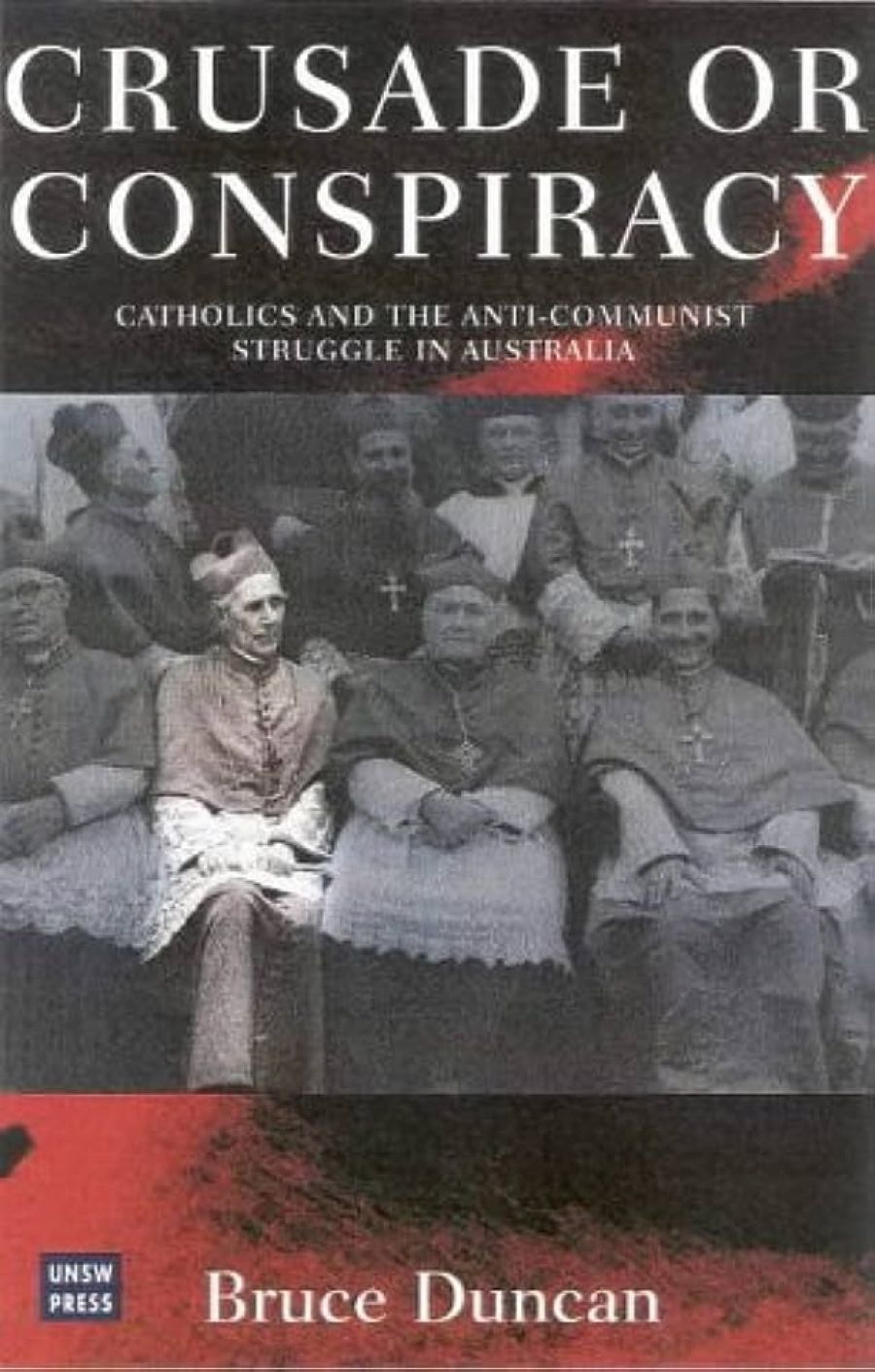
- Free Article: No
- Contents Category: Religion
- Review Article: Yes
- Article Title: Sly Seekers after Power
- Online Only: No
- Custom Highlight Text:
This lengthy analysis of Catholics and the anti-Communist struggle in Australia during the 1950s uncovers important and previously unreleased primary sources. In line with the author’s background as a Catholic Redemptorist priest, this particularly applies to material from Australian church archives and those of the Vatican, and from the files of B.A. Santamaria’s anti-Communist ‘Movement’. At the time, Santamaria’s ‘crusade’ against the atheistic and allegedly revolutionary Communist Party was strongly supported by the Redemptorist order, especially in Victoria.
- Book 1 Title: Crusade or Conspiracy?
- Book 1 Subtitle: Catholics and the anti-communist struggle in Australia
- Book 1 Biblio: UNSW Press, $49.95 pb, 491 pp
A prime weakness of Crusade or Conspiracy? is that Father Duncan too readily portrays the Sydney bishops and especially our first Australian-born cardinal, Archbishop Norman Gilroy, as being pure as driven snow, and that he characterises Santamaria and the ageing Archbishop Mannix as being sly seekers after political power. In fact, of course, the NSW bishops and Sydney’s Bishop James Carroll in particular were devious pragmatists, intimately connected with the powerful ALP machine.
Another weakness of the book is that, amid the welter of detail, Duncan often finds it hard to focus upon what is important. This includes identifying matters of historical relevance and also of contemporary interest. Thus it is puzzling that Sir William Deane’s membership of the Democratic Labor Party is relegated to a footnote on page 446. Indeed, as Duncan reveals, our current Governor-General, largely influenced by the anti-Communist poet and Quadrant editor, James McAuley, joined the DLP for ‘about two years’ in 1956 or 1957 and was a member of its executive. This is surely worthy of exploration in the text, as are the facts that Deane never stood as a candidate for election and that he soon became ‘disillusioned with the factionalism of politics’.
Hidden among the plethora of material are some matters of considerable significance. Thus it is important to understand that in early 1936 a youthful Bob Santamaria unambiguously emphasised that capitalism was ‘Public Enemy No. 1’ and ‘intrinsically more evil than Communism’. This connects with Santamaria’s latter incarnation at the end of his life as a committed but distinctly unfashionable opponent of unfettered and deregulated transnational capitalism and of so-called ‘economic rationalism’. In this anti-free trade and pro-protectionist cause, Santamaria was joined by a number of prominent ex-members of the Communist Party of Australia and by erstwhile ALP opponents, most notably Clyde Cameron.
In regard to the question of the Movement’s aim to achieve ‘control’ of the trade union movement and the ALP, it is instructive to learn that in December 1952 Santamaria wrote to Archbishop Mannix that the Movement was in a position ‘to implement a Christian social programme in both State and Federal spheres’. Santamaria confidently predicted that, by the end of the 1950s, the Movement would be able ‘to completely transform the leadership of the Labor Movement’ and introduce large numbers of Movement associates and sympathisers into our state and national parliaments. As Duncan rightly comments, ‘Had the Communists been in a position of such influence, the Movement would undoubtedly have considered it amounted effectively to “control” of the ALP’.
In the third last chapter, ‘Defying the Vatican’, Duncan recounts how in the Sydney Morning Herald of 1 September 1958, Sir William Deane’s mentor and Bob Santamaria’s great supporter, James McAuley, vociferously attacked the policies of Cardinal Gilroy and Bishop Carroll. For McAuley, the issue was fundamentally a question of clericalism versus the rights of committed anti-Communist laymen. But McAuley also accused the ‘Gilroy Catholics’ of treading the same path as the ‘regime Catholics’ of Eastern Europe: ‘They have even voted with Communists at meetings against Right-wing ALP Members.’ When a Sydney priest asked McAuley if controversy with the Cardinal did not shake his faith, McAuley replied: ‘Why should you think because my bishop is a liar and a schemer that this somehow disproves the fact that Christ rose from the dead?’
Unfortunately, due to Father Duncan’s inability to tell a fascinating story, such gems are few and far between in this exhaustive account of Catholic anti-Communism in Australia.


Comments powered by CComment